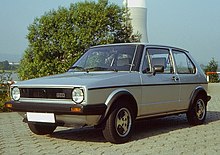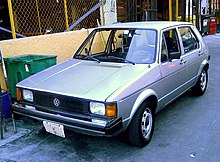Volkswagen Golf Mk1
[7]: 241 Local competitors Ford-Werke and Opel launched new small car models (the Escort and Kadett, respectively) targeted directly at Volkswagen's traditional market.The German government responded with emergency measures banning private car use on certain days of the week and comprehensive speed limits.From October 2, 1974 to January 14, 1975 two Golf Mk1s were driven over 30,500 km (19,000 mi) from Fairbanks, Alaska to Tierra del Fuego as a test of their durability.[29] In December 1975 a minor styling revision deleted the Swallowtail line on the rear hatch, replacing it with a simple straight horizontal body-line.[30] A minor exterior revision in December 1978 replaced the narrow front and rear bumpers with moulded units that wrapped around the sides of the car.Another minor facelift in 1980 saw the adoption of wider rear lamp clusters and a new dashboard with a more modern-looking instrument display featuring LED warning lights.[32] Due to the negative political reaction to the 1973 release of the Beetle "Gelb-Schwarzer Renner" ("GSR", or "Yellow-Black Racer"), Volkswagen had little inclination to develop a faster Golf.[34] The two were joined by Gunter Kühl from the Press department, suspension expert Herbert Schuster, Hermann Hablitzel, who smuggled parts from the project into regular tests, Jürgen Adler, whose chassis analysis led to additional reinforcements, Horst-Dieter Schwittlinsky from the marketing department who coined the "GTI" acronym, and Franz Hauk, developer of the EA827 engine.When this prototype was driven by Volkswagen's Chief of Research Ernst Fiala, he objected to the harsh suspension and excessive noise from the intake system and declared the car "undriveable".The car's name is typically described as an acronym of either the Italian phrase "Gran Turismo Iniezione", or the English "Grand Tourer Injection", and is usually written in all capitals.These were distinguished externally by a quad-lamp front grille, tinted glass, factory sliding sunroof and Pirelli P 6Jx14 alloy wheels.Equipping a compact car with a heavier, noisier and less powerful diesel engine was unusual in Germany at the time, with Peugeot among the few competitors offering a comparable model.Essentially a Golf Mk1 with a trunk grafted on, this three-box sedan body style was offered in two- and four-door versions and was targeted at more conservative buyers.This early prototype lacked the roll-over bar of the later version, and had a flat body line in the rear, where the soft top folded down below the sill level.All Cabriolets from 1988 onward left the factory fitted with a "Clipper" body kit that featured smooth body-coloured bumpers, wheel-arch extensions, and side skirts.It was only in late 1983, with the introduction of the 1984 models, that an officially badged GTI version of the Cabriolet finally became available in the UK (the GLI continued in mainland Europe).[59] The Mk1 Golf Van was marketed as a light-duty commercial vehicle, and consisted of a Mk1 body with the glass in the greenhouse's rear side openings replaced by steel panels.[citation needed] The 1980 Caribe lineup remained essentially unchanged except for a slightly restyled front grille with squared type headlamps.[62] In 1981 an improved Caribe was offered to the Mexican market, with looks matching the recently face-lifted North American-spec Mk1 Golf: the Volkswagen Rabbit.Former Chevrolet engineer James McLernon was chosen to run the factory, which was built to lower the cost of the Rabbit in North America by producing it locally.McLernon moved to "Americanize" the Golf/Rabbit (Volkswagen executive Werner Schmidt referred to the act as "Malibuing" the car) by softening the suspension and using cheaper materials for the interior.[70] The color schemes also changed; period testers noted a lower quality of materials being used, although fit and finish was as high as on German-made cars.[71] This model was short-lived, with 1981 Rabbits receiving a facelift with wraparound turn signals and larger taillights, while the diesel engine was changed to a 52 hp (39 kW; 53 PS) 1588 cc unit.[74] For 1981 the gasoline powered Rabbit received a fuel injected 1,715 cc (104.7 cu in) engine, an iteration used only in North America, which offered 74 hp (55 kW).The squared styling of the front end, particularly the wraparound direction indicator lights, gave it added safety and slight improvement in performance.These Canadian cars were German-built and were nearly identical in body shell and interior appearance to the 81 kW (110 PS; 109 hp) Golfs built in Europe.A small number of European specification GTIs made it to Canada under an agreement with the government that allowed foreign soldiers training at Canadian military facilities to bring their personal vehicles with them.The later Citi Golfs feature modern amenities such as a new dashboard adapted from a Škoda Fabia, and minor body "facelifts" such as revised tail-light clusters.This crossover-like car started with a Mk1 Cabriolet body and mounted the engine, transmission and Syncro four-wheel-drive system from the MkII Golf Country using a custom subframe.In the late 1970s, the Mk1 Golf GTI was campaigned in a variety of international rallying events, taking wins at Sweden (1978, 1982, 1983), Monte Carlo (1980), Great Britain (1983), and Portugal (1984).














Volkswagen GolfAutostadt ("ZeitHaus" exhibitions section)WolfsburgVolkswagenVolkswagen Citi GolfClaytonBrusselsNew Stanton, PennsylvaniaWestmoreland AssemblyUitenhageShah AlamPuebla, PueblaSarajevoDesignerGiorgetto GiugiaroItaldesignSmall family carBody stylehatchbackpickup truckconvertibleLayoutFF layoutPlatformVolkswagen JettaVolkswagen CaddyVolkswagen SciroccoEnginePetrol enginesDiesel enginesTransmissionmanualautomaticWheelbaseCurb weightVolkswagen BeetleVolkswagen Golf Mk2rear-wheel drive and rear-mountedair-cooled enginesfront-wheel drive with front-mountedBeetlePorscheHeinz NordhoffPininfarinaDer SpiegelType 3BrasíliaVolkswagen do BrasilunibodyVolkswagen Type 4Volkswagen air-cooled engineVolkswagen Type 3Auto UnionDaimler-BenzWandererKurt LotzVolkswagen K70rear mid-engine, rear-wheel-drive layoutFord-WerkeEscortKadettNixon shockDeutsche MarkOPEC oil crisisCenter for Auto SafetyRalph NaderUnsafe at Any SpeedChevrolet CorvairRudolf LeidingTurin Auto ShowFiat 128C-segmentPassatSciroccoFairbanks, AlaskaTierra del FuegoWhat Car?Austin MetroFord EscortYanaseEuropean Car of the YearCitroën CXSFR YugoslaviaSR Bosnia and HerzegovinaMostarrocker armsMacPherson strutscoil springsanti-roll bartwist-beam rear suspensionshock absorbersEA827 PetrolElectro-Mechanical injectionTorsion beam axlebrake boosterskunkworks projectErnst FialaGrand Tourer Injectiongolf ballGroup Onestrokedisplacedcompression ratioclose-ratiomanual transmissioncurb weighthot hatchAutobianchi A112 AbarthSports Car InternationalFriedrichsdorfdouble-overhead camPirelliPeugeotnoise, vibration, and harshnessVogošćaVolkswagen Jetta (A1)Wilhelm Karmann GmbHGolf IIEtienne Aignerforced inductionGarrettturbochargerhead gasketheat exchangerGolf MkIIWestmoreland plant